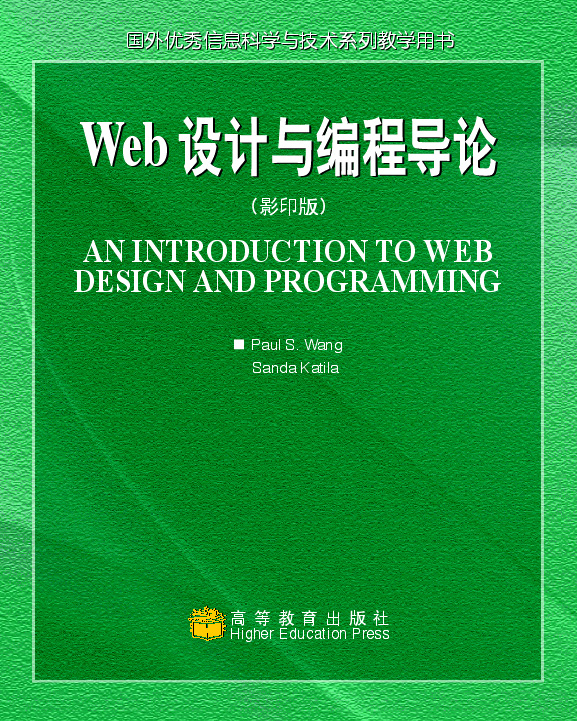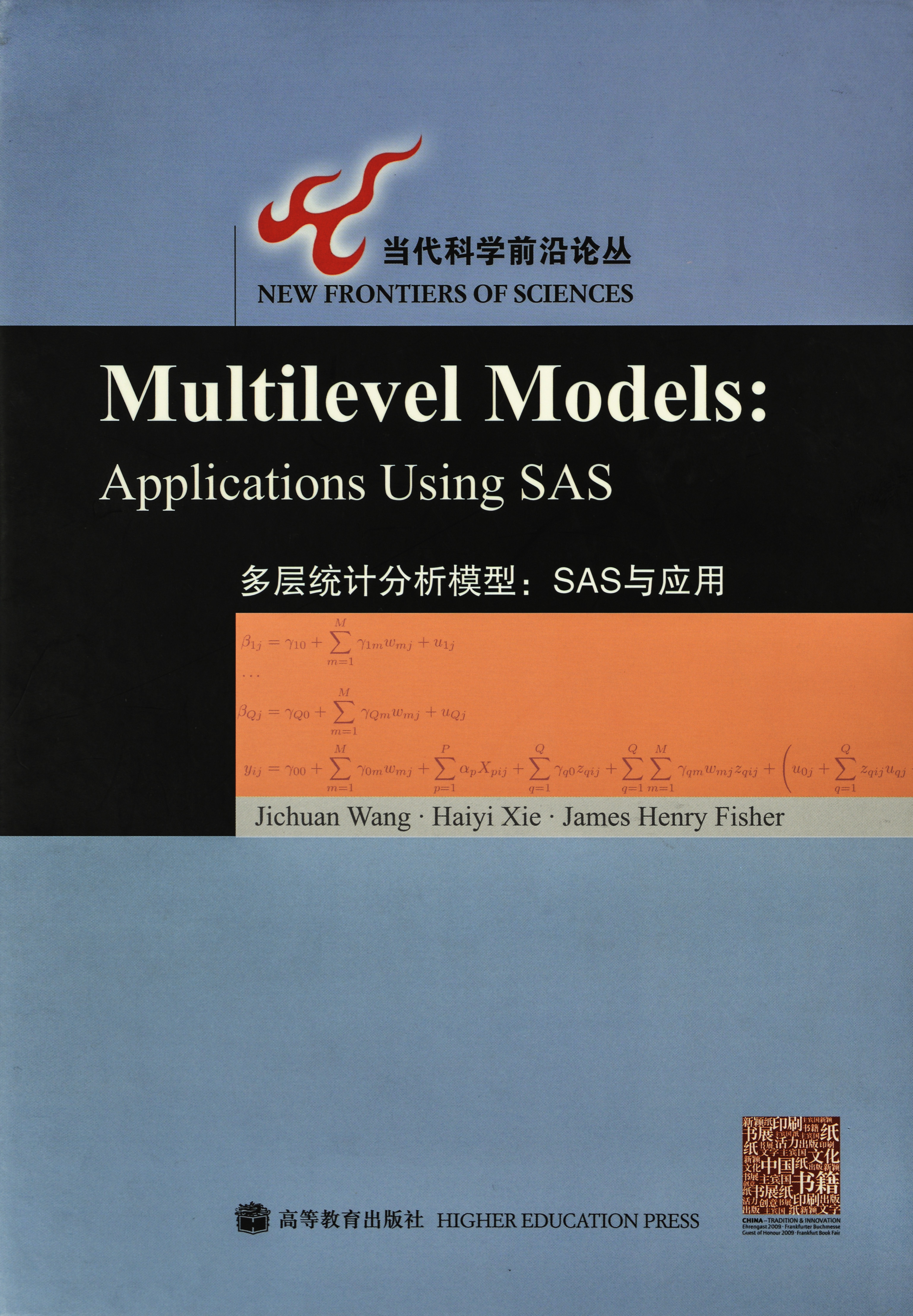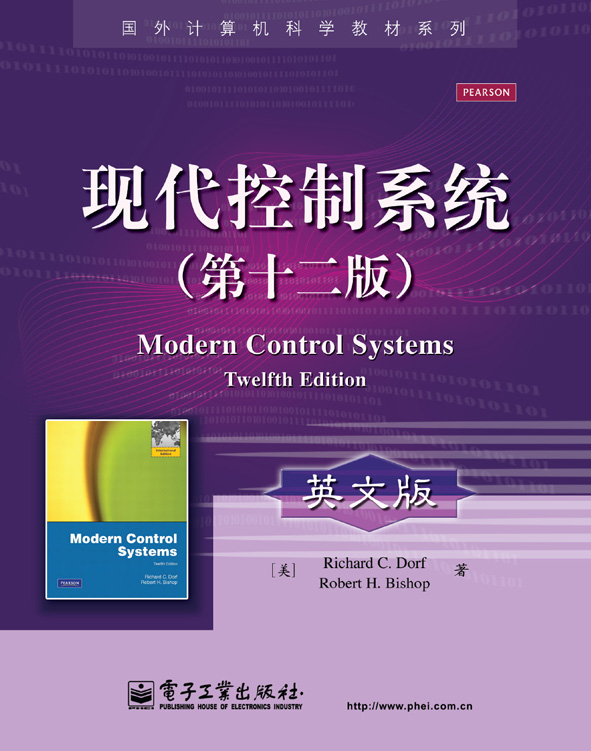Web设计与编程导论(影印版)
作者: [美]Paul S. Wang, Sanda Katila
出版时间:2004-08-13
出版社:高等教育出版社
- 高等教育出版社
- 9787040155426
- 1
- 248693
- 平装
- 16开
- 2004-08-13
- 720
- 572
- 工学
- 计算机科学与技术
《Web设计与编程导论(影印版)》从程序设计技术和视觉传达设计的角度向读者讲述了Web开发的知识。主要技术涉及XHTML、CSS、JavaScript、DOM、DHTML、HTTP、Perl、CGI,展示其在Web开发实践活动中起到的促进作用。《Web设计与编程导论(影印版)》主要特征包括:介绍Web设计原理与方法,为设计功能性强、逻辑合理、易用、高效和吸引受众的网站提供各方面知识,如信息体系结构、视觉传达设计、色彩与图形、视觉层次、对称与平衡、统一与变化,还有设计工具,如编码、图像处理、模板生成、网站集成、测试与调试;讲解Web设计集成化方法;提供程序设计实例和练习。《Web设计与编程导论(影印版)》辅以网站/wdp,提供在线图表、可运行实例、实验包和团队项目指导等丰富的教学辅助资源。
《Web设计与编程导论(影印版)》适用于高等院校工科各专业本科Web开发类课程,对相关Web设计与编程人员也有很好的参考价值。
INTRODUCTION
CHAPTER 1 Web Basics and Overview
1.1 About Networking
1.2 The Internet
1.3 The Domain Name System
1.4 The Web
1.5 Content Types
1.6 Putting Information on the Web
1.7 What Is HTML?
1.8 Web Hosting
1.9 Domain Registration
1.10 What Are Name Servers?
1.11 Looking Up Host Information
1.12 The Web Development Process
1.13 Dynamic Generation of Web Pages
1.14 HTTP Briefly
1.15 Summary
Exercises
CHAPTER 2 Creating Web Pages: XHTML
2.1 HTML Basics
2.2 Creating Your First Web Page
2.3 Elements and Entities
2.4 A Brief History of HTML
2.5 XHTML Syntax
2.6 Core Attributes
2.7 Headings and Paragraphs
2.8 White Space and Line Wrapping
2.9 inline Elements
2.10 Controlling Presentation Styles
2.11 Length Units
2.12 Colors
2.13 Text Fonts
2.14 Lists
2.15 List Styles
2.16 Hyperlinks
2.17 Images
2.18 Positioning Inline Images
2.19 Image Maps
2.20 Editing HTML
2.21 Summary
Exercises
CHAPTER 3 Advanced XHTML
3.1 Character Encoding
3.2 Special Symbols and HTML Entities
3.3 Tables
3.4 Cell Content Alignment
3.5 Displaying Tables
3.6 Formatting Tables
3.7 Positioning Tables
3.8 Table Width and Height
3.9 Grouping Rows and Columns
3.10 Nesting Tables
3.11 Using Tables for Page Layout
3.12 Pagewide Style with body
3.13 Head Elements
3.14 Search Engine Ready Pages
3.15 Forwarding Pages
3.16 Portable Pages
3.17 Web Site Icons
3.18 Frames
3.19 Server-Side Includes
3.20 Internationalization
3.21 Common Page Errors
3.22 Page Checking and Validation
3.23 For More Information
3.24 Summary
Exercises
CHAPTER 4 Design Basics
4.1 What Is Design?
4.2 Design and Perception
4.3 Brief History of Design on the Web
4.4 Elements of Design
4.5 Unity and Variety
4.6 Emphasis, Focal Point, and Hierarchy
4.7 Contrast
4.8 Visual Balance
4.9 Summary
Exercises
CHAPTER 5 Information Architecture, Page Layout, and Typography
5.1 Layout Overview
5.2 Web Site Architectures
5.3 Information Architecture
5.4 IA Case Study: CVB
5.5 Client Identity
5.6 Organizational Framework
5.7 Typography Basics
5.8 Type Families
5.9 Choosing Type
5.10 Spacing Type
5.11 Reading Type on the Web
5.12 Layout Grids
5.13 Web Page Layout Grids
5.14 Designing Layout Grid Systems
5.15 Grids on the Web: A Critique
5.16 Summary
Exercises
CHAPTER 6 Controlling Page Style: Cascading Style Sheets
6.1 What Is CSS?
6.2 Overall Styling of a Page
6.3 Centering and Indenting
6.4 Selectors
6.5 Hyperlink Styles
6.6 Conflicting Rules
6.7 Style Properties
6.8 A Navigation Bar
6.9 Page Formatting Model
6.10 Setting Margin, Border, and Padding
6.11 Navbar Using Borders
6.12 Border Properties
6.13 Styled Buttons
6.14 Formatting Text
6.15 Elastic Banners
6.16 Rollover Navigation Bars
6.17 Piecing Images Together
6.18 Background Images
6.19 List and Other Style Properties
6.20 Positioning
6.21 Printer-Friendly Pages
6.22 CSS and Page Layout
6.23 The Cascade
6.24 For More Information
6.25 Summary
Exercises
CHAPTER 7 Color and Graphics
7.1 A Historical Note on Color Theory
7.2 The Color Wheel
7.3 Color Harmony
7.4 Color Contrast
7.5 Color for the Web
7.6 The Meaning of Color
7.7 Color and Readability
7.8 Color on Computers
7.9 What Is Gamma?
7.10 Color Models and Color Encoding
7.11 Color Palettes
7.12 Image Encoding Formats
7.13 Web Samples Color Critique
7.14 Color Application
7.15 Summary
Exercises
CHAPTER 8 Forms and Form Processing
8.1 What Is a Form?
8.2 A Historical Note
8.3 Form Basics
8.4 Text Input
8.5 User Selections
8.6 Submit Buttons
8.7 File Uploading
8.8 Other input Elements
8.9 Tabbing Order
8.10 Form Layout
8.11 HTTP Basics
8.12 HTTP Message Format
8.13 CGI Overview
8.14 Outline of a CGI Program
8.15 Getting Started with CGI Programming
8.16 Deploying CGI Programs
8.17 CGI Example: Club Membership
8.18 CGI Environment Variables
8.19 Data Received on the Server Side
8.20 Content Length
8.21 Summary
Exercises
CHAPTER 9 Client-Side Scripting: JavaScript
9.1 Getting Started
9.2 Embedding JavaScript in a Web Page
9.3 A Brief History of JavaScript
9.4 Rollovers
9.5 Preloading Images
9.6 Active Navigation Bars
9.7 Making Comparisons
9.8 Built-in Functions
9.9 Matching Patterns
9.10 Patterns
9.11 JavaScript Objects
9.12 Windows
9.13 Creating User Interactions
9.14 A Conversion Calculator
9.15 Form Checking
9.16 Menu Actions
9.17 Events and Event Objects
9.18 Scrolling Text
9.19 Testing and Debugging
9.20 For More Information
9.21 Summary
Exercises
CHAPTER 10 Document Object Model and Dynamic HTML
10.1 What Is DOM?
10.2 A Demonstration
10.3 DOM History and Architecture
10.4 Browser Support of DOM
10.5 DOM API Overview
10.6 Getting Started with DOM
10.7 The DOM Node Interface
10.8 DOM Tree Depth-First Traversal
10.9 The DOM HTMLElement Interface
10.10 HTMLBlement Fields and Methods
10.11 A Guided Form
10.12 Fade-in Headlines
10.13 Mouse Tracking
10.14 The DOM HMDocument Interface
10.15 Generating New Content
10.16 A Smart Form
10.17 Reordering Rows in Tables
10.18 A Tic-Tac-Toe Game
10.19 Windows and Frames
10.20 A Code Experimenter
10.21 DHTML Access to Web Services
10.22 For More Information
10.23 Summary
Exercises
CHAPTER 11 Graphics and Site Production
11.1 Graphics for the Web: Using Photoshop
11.2 Cropping and Scanning
11.3 Types of Artwork
11.4 Tools for Web Graphics: A Brief Overview
11.5 Color Adjustments
11.6 Typical Image Processing Tasks
11.7 Designer-Programmer Cooperation
11.8 From Layout Design to HTML Code
11.9 Guide on Rules and Layout Table
11.10 Rollover Navigation Bars
11.11 Creating CSS in Dreamweaver
11.12 Page Template Production
11.13 Saving Original Files and Working Graphics
11.14 Site Deployment
11.15 Summary
Exercises
CHAPTER 12 Audio and Video
12.1 A Brief History of Audio and Video on the Web
12.2 Designing Multimedia
12.3 Audio on the Web
12.4 Sampling and Quantization
12.5 Audio Compression and File Formats
12.6 What Is MP3?
12.7 Sound In Web Pages
12.8 Serving Up MP3
12.9 How to Obtain,Produce,and Edit Audio
12.10 Video on the Web
12.11 Digital Video Compression
12.12 Video in Web Pages
12.13 Video Streaming
12.14 How to Obtain, Produce, and Edit Video
12.15 Introduction to Flash
12.16 Flash Overview
12.17 Publishing Flash Movies
12.18 Flash Movie Example
12.19 Summary
Exercises
CHAPTER 13 Perl and Common Gateway Interface Programming
13.1 What Is Perl?
13.2 A Brief History of Perl
13.3 Perl Programming ABC
13.4 Perl Variables
13.5 Arithmetic and String Operators
13.6 True or False
13.7 Automatic Data Context
13.8 Conditional Statements
13.9 Perl VO
13.10 Perl iterations
13.11 Defining Functions
13.12 A Form To Mail Program
13.13 Pattern Matching in Perl
13.14 Substitutions
13.15 Simple Page Search
13.16 Perl Built-in Functions
13.17 Handling Passwords
13.18 Taint Mode
13.19 The Perl CGI Module
13.20 Handling File Uploading
13.21 Testing and Debugging Scripts
13.22 Session Control
13.23 Sessions under HTTP
13.24 What Is a Cookie?
13.25 Cookies in CGI Programs
13.26 Cookie Example
13.27 Summary
Exercises
PHOTOS
INDEX








